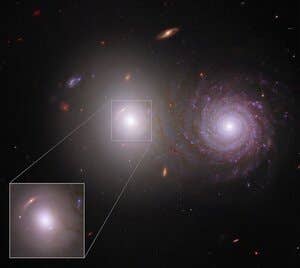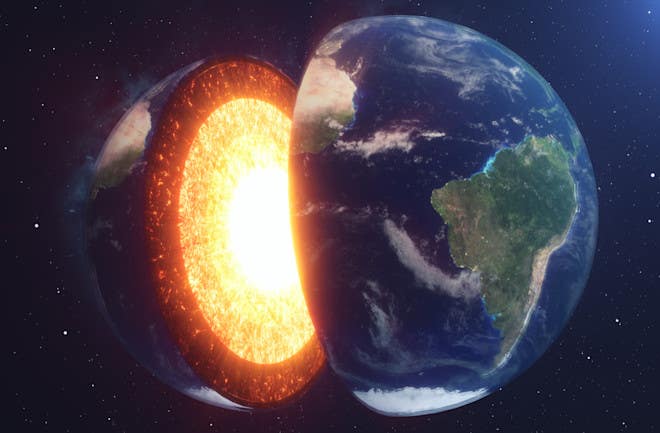Webb Telescope discovers ‘weird’ galaxy that is outshining stars
Discover GS-NDG-9422, a galaxy where gas outshines stars, offering insights into early cosmic evolution with the James Webb Telescope.

A galaxy from a billion years after the Big Bang, GS-NDG-9422, reveals an unprecedented glow with gas outshining stars. Discover what it means for cosmic evolution. (CREDIT: European Space Agency)
The cosmos has always been a realm of the unexpected, and a recent discovery by the James Webb Space Telescope (JWST) has delivered yet another surprise. Astronomers have identified a peculiar galaxy, GS-NDG-9422, existing roughly a billion years after the Big Bang.
This discovery not only offers a glimpse into the early stages of the universe but could also shed light on the evolutionary phases of galaxies during the cosmic dawn.
What sets this galaxy apart is its remarkable light signature. Unlike most galaxies, where starlight dominates the spectrum, the gas in GS-NDG-9422 emits more light than its stars. This phenomenon, described as "totally new" by researchers, could represent a missing link in the transition from the universe’s first stars to the more familiar galaxies we observe today.
Dr. Alex Cameron of the University of Oxford described the initial observation as “weird,” a term that underscores the novelty of this discovery. “That’s exactly what the Webb telescope was designed to reveal: totally new phenomena in the early Universe that will help us understand how the cosmic story began,” Cameron explained.
The findings, now published in the Monthly Notices of the Royal Astronomical Society, highlight the potential of JWST to explore uncharted cosmic territories.
The spectrum of GS-NDG-9422 reveals an interplay of extreme conditions. Computer simulations suggest that dense gas clouds are heated by massive, extraordinarily hot stars. These stars, with temperatures exceeding 140,000 degrees Fahrenheit (80,000 degrees Celsius), are far hotter than their local universe counterparts, which typically range between 70,000 and 90,000 degrees Fahrenheit (40,000 to 50,000 degrees Celsius).
This intense heating generates an outpouring of photons, causing the gas to shine with an almost unmatched brilliance. Dr. Harley Katz, a theorist from Oxford and the University of Chicago, remarked, “It looks like these stars must be much hotter and more massive than what we see in the local Universe, which makes sense because the early Universe was a very different environment.”
Interestingly, while these stars resemble those predicted for the universe’s first generation of stars, known as Population III stars, they are not the same. Webb’s data indicates a level of chemical complexity inconsistent with primordial stars. However, the exotic nature of these stars offers critical clues about how galaxies evolved from their primordial states into the more chemically complex systems we observe today.
Related Stories
Central to understanding GS-NDG-9422 is its strong nebular emission. This emission consists of free-bound, free-free, and two-photon processes, which collectively contribute to the light we see.
The most prominent feature, the Balmer jump, results from electrons recombining with ionized hydrogen. This discontinuity in the spectrum is a hallmark of young, star-forming galaxies with high ionizing photon production efficiencies.
Simulations and observations, such as those by Wilkins et al. (2024) and Katz et al. (2023), suggest that features like the Balmer jump may have been common in high-redshift galaxies. However, the two-photon component, often linked to extremely hot stars, remains rare. GS-NDG-9422’s spectrum hints at a strong two-photon emission, a phenomenon previously seen only in isolated cases like the Lynx arc.
“This galaxy provides a rare opportunity to study these extreme conditions,” said Katz. “It could guide us in understanding how the earliest galaxies transitioned to the types we see today.”
While GS-NDG-9422 is currently a singular example, it opens doors to critical questions about galactic evolution. Are such conditions typical for galaxies of this era, or is this an outlier? Could similar galaxies help bridge gaps in our understanding of how primordial stars gave way to chemically diverse systems?
The researchers, including Cameron and Katz, are now expanding their search for other galaxies with similar properties. By building a population of such examples, they hope to unravel the mysteries of the universe’s first billion years.
Cameron expressed optimism about the potential of JWST to redefine cosmic exploration. “It’s a very exciting time to be able to use the Webb telescope to explore this time in the Universe that was once inaccessible,” he said. “We are just at the beginning of new discoveries and understanding.”
Through its unprecedented sensitivity to near-infrared light, the JWST is transforming our ability to study high-redshift galaxies. From providing detailed insights into interstellar media to confirming the highest spectroscopic redshifts, its impact is profound.
For GS-NDG-9422, and countless other yet-to-be-discovered galaxies, the telescope is not merely a tool—it’s a gateway to the cosmos.
Note: Materials provided above by The Brighter Side of News. Content may be edited for style and length.
Like these kind of feel good stories? Get The Brighter Side of News' newsletter.
Joshua Shavit
Science & Technology Writer | AI and Robotics Reporter
Joshua Shavit is a Los Angeles-based science and technology writer with a passion for exploring the breakthroughs shaping the future. As a contributor to The Brighter Side of News, he focuses on positive and transformative advancements in AI, technology, physics, engineering, robotics and space science. Joshua is currently working towards a Bachelor of Science in Business Administration at the University of California, Berkeley. He combines his academic background with a talent for storytelling, making complex scientific discoveries engaging and accessible. His work highlights the innovators behind the ideas, bringing readers closer to the people driving progress.



